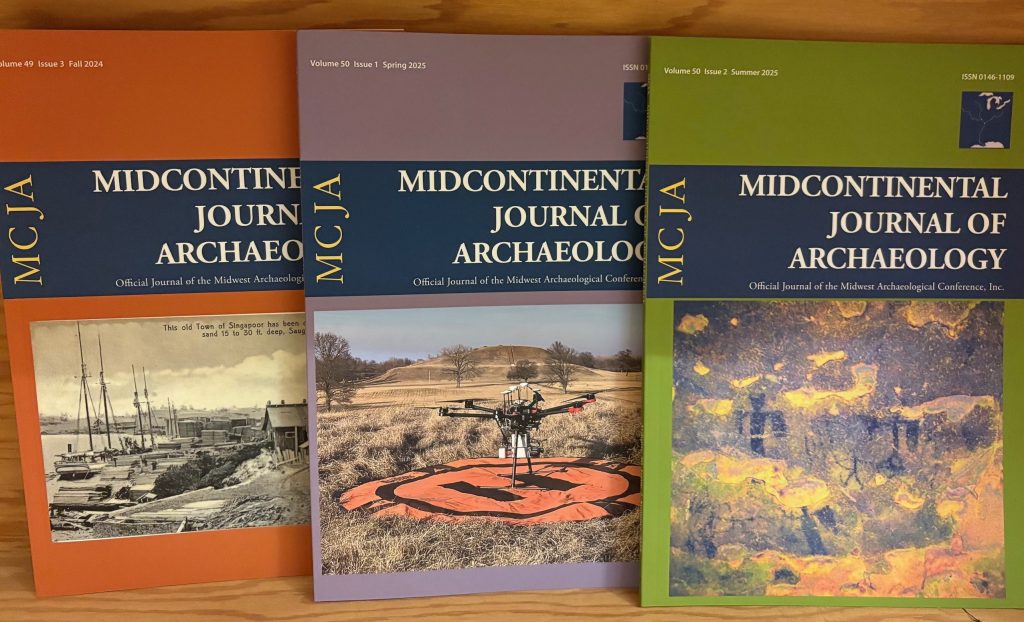
Whether you’re attending the Midwest Archaeological Conference (MAC) October 29–November 1, 2025, or just following along virtually, it’s the perfect time to get to know the society’s official journal, the Midcontinental Journal of Archaeology.
Edited by Robert A. Cook, the mission of the journal follows that of MAC: to promote and stimulate interest in the archaeology of the midwestern United States and neighboring areas; to serve as a bond among those interested in this and related subjects; to advocate for the conservation of archaeological data; and to encourage an appreciation and support of regional archaeological research.
Check out some of our featured articles, learn about how to submit your work, and more.
Reading List
“Portable X-Ray Fluorescence Analysis of Rock Art Paintings in Southern Illinois” by Sierra M. Bow, Jan F. Simek, and Mark J. Wagner
Illinois contains a rich tradition of American Indian rock art dating to the precontact Mississippian and postcontact periods (AD 1000–1835). One long-standing question about this art involves the nature of the paints used to make it. Ethical concerns about the destructive removal of pigment samples, however, have limited compositional investigations. Here, the authors used portable X-ray fluorescence technology in situ to noninvasively examine the elemental composition of a selection of Illinois pictographs. They analyzed pictographs from seven sites across southern Illinois to (1) determine the paint ingredients and (2) assess variability in the paint recipes.
“High Resolution Lidar Drone Imagery Assessment of the Rattlesnake Mound Complex at Cahokia, Illinois, USA” by William F. Romain, Edward W. Herrmann, Harrison Martin, Eric A. Barefoot, and Steve Scott
In this article, the authors report the results of a high-resolution lidar drone survey focused on the Rattlesnake Mound Complex at Cahokia Mounds State Historic Site. Using lidar imagery supplemented by aerial photographs, they present new data concerning a series of low mounds that surround Rattlesnake Mound. To date, only two of these mounds have been documented in detail.
*Open Access* “Current Evidence Does Not Support a Hopewell Age, Provenience, or Affiliation for the Figurine Allegedly from Hopeton Earthworks or the Hopewell Mound Group” by Michelle R. Bebber, Jeremy C. Williams, Maximilian Barczok, and Metin I. Eren
Everhart and Biehl’s research, discussed within, questions our conclusions regarding a ceramic figurine allegedly from Hopeton Earthworks. They conclude that the figurine is culturally Hopewell and that its provenience is the Hopewell Mound Group. Here, the authors demonstrate that there is no verified provenience for the figurine and no evidence for validly inferring a Hopewell affiliation. Instead, the preponderance of evidence is consistent with the hypothesis that the figurine is non-Hopewell in origin.
“An Archaeoastronomic Assessment of Angel Mounds, Indiana, with Commentary on Moundville, Alabama, and Cahokia, Illinois” by William F. Romain and Edward W. Herrmann
The Angel Mounds site was a large, fortified Mississippian village located in southwestern Indiana. The site flourished from circa AD 1100 to AD 1450 and represents one of the largest recorded Mississippian settlements in the Ohio River valley. In this article, the authors use astronomic data, lidar imagery, ethnohistoric data, and computer planetarium simulations to identify solar, stellar, and lunar alignments at the site.
Submit Your Work
If you’re interested in submitting your work, the Midcontinental Journal of Archaeology seeks original articles on Eastern Woodlands archaeology of the region between the Appalachian Mountains and the Great Plains, from the Boreal Forests to the Gulf of Mexico, and on closely related subjects. Contributions range in chronology and context from the kill sites of the continents’ first inhabitants to the privies of early 20th-century city dwellers. The Journal is especially interested in manuscripts that apply contemporary theory or method to existing problems and data sets in the midcontinent and that are of broad, general interest across the region.
Find Out More
- Individual memberships can be made through the Midwest Archaeological Conference.
- To recommend this title to your library, fill out this Library Request Form and provide to your library via email or in person. Many institutional libraries also have an online form you can fill out on their websites.
